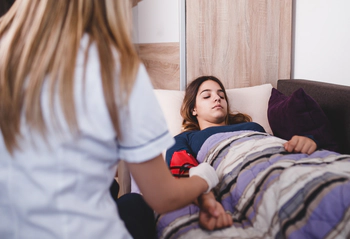In Some Schools, One in Four Children Say They’ve Experimented with ADHD Drugs
This article highlights findings from a recent study that found potentially 25% of American adolescents are experimenting with ADHD drugs that they primarily get from peers who have legitimate prescriptions for the medications.

Recent findings that show skyrocketing rates of ADHD medication experimentation in school highlight the importance of parents having open and honest conversations with kids about the dangers of self-medicating on pharmaceutical drugs.
One in Four U.S. Teens at Some Schools Say They’ve Experimented with Prescription Stimulants
A group of researchers at the University of Michigan’s Center for the Study of Drugs, Alcohol, Smoking, and Health examined nearly 3,300 U.S. middle and high schools, finding that some schools have serious problems with students misusing prescription stimulant medications. Critically, the schools with the highest rate of misuse (up to 25% of the student body at some schools) also happened to be schools with a higher-than-average number of students on legitimate prescriptions for stimulant medication.1
The researchers found that the most frequently misused drugs in the schools were ADHD drugs, like Ritalin (methylphenidate), Adderall (amphetamine/dextroamphetamine), and Concerta (methylphenidate). According to the researchers, many students said they were self-medicating on stimulants because they erroneously believed the drugs would improve their memory, make them sharper, and boost their performance during tests. Other students used the drugs to get high, lose weight, or experiment.
But why were some school systems reporting record levels of prescription stimulant misuse when others were not even registering concern about such misuse? “Stimulant misuse was as low as zero at some schools and as high as over 25% at others,” says Sean Esteban McCabe, director of the University of Michigan’s Center for the Study of Drugs, Alcohol, Smoking, and Health and leading author of the study. According to McCabe and his team, the difference depended on the proportion of students at the school who were already on prescriptions for pharmaceutical stimulants.2
According to the research, children who attended schools with 12% or more of the student body on ADHD medication were 36% more likely to say they’d misused prescription stimulants. Conversely, children and teens at schools where no students were on medications for ADHD were far less likely to say they’d experimented with prescription stimulants.
The findings paint a grim picture. The presence of mind-altering drugs, albeit legal pharmaceutical drugs, in a community of young people (like a school) directly connects to increasing rates of misuse of such drugs in that community. The research suggests more work needs to be done to prevent young people who do not have prescriptions for stimulant drugs from seeking them and to prevent young people who have prescriptions from sharing them.
What Happens When People Misuse Prescription Stimulants?

Just because it’s a prescription drug does not make it safe. Experimenting with prescription stimulants when one does not have a prescription for them (or taking them in any way other than as advised by one’s doctor when one does have a prescription) can lead to life-threatening overdoses. Side effects like irregular heartbeat, high body temperature, and seizures can also occur.3
Also, pharmaceutical stimulants carry risks even when used as directed. Some of the short-term effects can include:
- Increased heart rate
- Increased blood sugar
- Increased blood pressure
- Increased breathing, hyperventilating
- Decreased blood flow, posing risks to the cardiovascular system
Psychosis, anger, paranoia, abrupt mood changes, and fatal overdose are all risks of experimenting with prescription stimulants.
Parents Must Take Action
Both for those with legitimate prescriptions for stimulant medication and those who are not currently on such drugs, parents must have conversations with their kids. Children on such prescriptions must be educated on how to respond to students peer pressuring them to share their meds. Children not using prescription stimulants must be educated on the harm of prescription misuse so they don’t develop an interest in experimenting with such drugs.4
Experts agree that education and parent/teacher involvement in children’s lives is critical to preventing drug experimentation. “It’s very important for parents to have conversations with their children about prescription medications from an early age, and to be a credible source of information about the risks of using any medication not specifically prescribed for you,” says Linda Richter, vice president of prevention research and analysis for the nonprofit Partnership to End Addiction. “Kids should understand that sharing their prescribed medication with a friend could be putting that friend at risk.” Parents must take a vested interest in their children’s ability to say no to various forms of peer pressure.
Addiction Treatment is There for Those Who Need It

When someone begins exhibiting changes in their behavior, relationships, sleep, or eating habits, or when they begin struggling at school or work, these may be signs they are suffering from an addiction to drugs. Such can occur even if they have a legitimate prescription for a drug.
If you know someone who is using a mind-altering substance like drugs or alcohol and who cannot stop using it on their own, please help them find and enter a qualified, residential drug addiction treatment center.
Sources:
-
JAMA. “Prescription Stimulant Medical and Nonmedical Use Among U.S. Secondary School Students, 2005 to 2020.” Journal of the American Medical Association, 2023. jamanetwork.com ↩︎
-
USNews. “In Some U.S. Schools, 1 in 4 Kids Said They’ve Misused an ADHD Drug.” U.S. News, 2023. usnews.com ↩︎
-
HealthyChildren. “Drug Abuse Prevention Starts with Parents.” Healthy Children, 2009. healthychildren.org ↩︎
-
NIDA. “Prescription Stimulants DrugFacts.” National Institute on Drug Abuse, 2018. nida.nih.gov ↩︎






 ®
®